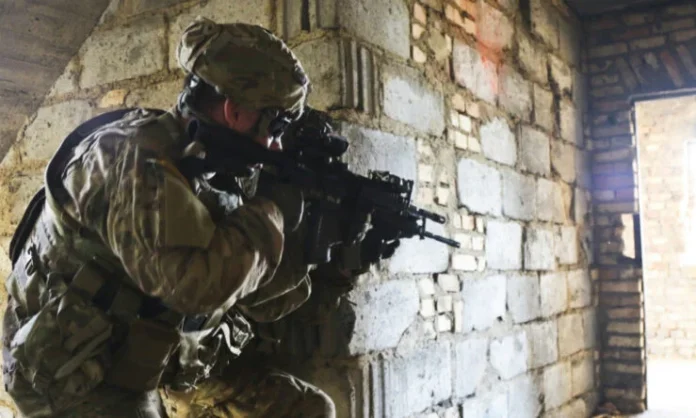The infantry will remain indispensable despite technological advances in warfighting because what eventually matters is where your boots are on ground. China is using this to nibble away at our territory on the premise that internationally ‘possession’ comprises 80 percent of the law. Infantry plays the main role in irregular and unconventional combat. Besides, built up areas and cities, which are death traps for armies, can only be taken and held with infantry support. That is why nations are arming and equipping their infantry for future combat by incorporating newer technologies.
Infantry in Modern Battlefield
The future battlefield with advanced technologies demands corresponding improvement in infantry capabilities in terms of surveillance, firepower, communications, network-centric warfare (NCW) capability, survivability and protection, plus mobility, which simply implies:
Surveillance: See the enemy much before he sees you and keep the battlefield under constant watch.
Firepower: Engage enemy in darkness and bad visibility (rain, fog, haze, smoke), mechanised columns, drones and low-flying helicopters-aircraft.
Communications: Secure communications immune to jamming.
NCW Capability: Soldier networked to the command and control centre having real-time common operational picture and sensor-to-shooter link.
Survivability and Protection: Ability to survive in all terrain, all weather environment, camouflage and protection from enemy fire (body armour), mines/IEDs, NBC protection, emergency treatment of battlefield casualties and survival rations.
Mobility: All-terrain mobility.
Logistics: By land, air and water bodies including unmanned vehicles.
America’s FFW Program
The Future Force Warrior (FFW) was a US military advanced technology demonstration project (part of the Future Combat Systems) that sought to create a lightweight, fully integrated infantryman combat system. Its basic features being: situational awareness, including Rifleman Radio; helmet-mounted display, plus location and physiological status monitoring; combat uniform with three layers – protective outer, power centric and life critical; microclimate cooling system, built into the life critical layer network of narrow tubing to provide heating-cooling, and power subsystem having 24-hour individual operation and 72-hour continuous team operations.
Future Infantry Soldier Technology System (FIST)
The FIST being adopted by the British and shared with the US Army includes the following main improvements:
Lethality: The 5.56mm SA-80 assault rifle will be fitted with an enhanced sighting system on the weapon or linked to the soldier’s helmet mounted sight allowing the soldier to fire around corners.
Clothing: Reduce the soldier’s visual, radar and IR signatures, provide personal temperature control and environmental protection; built in wires or Bluetooth technology to interconnect FIST components. Body armour selected for different operational requirements. The integrated helmet will provide ballistic protection, interface to other elements and display battlefield situations.
NBC Protection: Provide NBC hazard warning. New lightweight and breathable materials are developed for NBC protection.
Power Supply: Future infantryman power requirements are estimated ten times higher than currently used. Designs will continue to be based on advanced lithium-ion battery technology until emerging technologies like fuel cells and advanced chargers are deployed.

Future Infantry Soldier As a System (F-INSAS)
India’s F-INSAS was launched to equip its infantry with advanced weaponry, communication network and instant access to information on the battlefield in line with soldier modernisation programs of other nations. It envisaged a fully networked all-terrain, all-weather personal-equipment platform, enhanced firepower and mobility for the digitised battlefield of the future.
F-INSAS was conceived in April 2005 as part of the Infantry Vision 2020. It was to be executed in three phases: Phase-1 – Weapons, Body Armour, Clothing, and Individual Equipment; Phase-2 – Target Acquisition System, and; Phase-3 – Computer Sub-System, Radio Sub-System, Software and Software Integration. The aim was to transform the infantryman into “a self-contained fighting machine”.
Phase-1 was to be completed in 2015. However, in January 2015, F-INSAS was split into two separate projects; one, arming the modern infantry soldier with the best available assault rifle, carbines and personal equipment like helmet and bulletproof vests, and, two; the Battlefield Management Systems (BMS).
Weapons: The weapons sub-system was to be built around a multi-calibre individual weapon system with thermal weapon sight and laser range finder and the fourth calibre attached to a grenade launcher. The UBGL (Under Barrel Grenade Launcher) was to be capable of firing airburst grenades. But the DRDO-OFB failed to develop a state-of-the-art assault rifle or for that matter small arms. The 5.56mm INSAS rifle did not match up with the top 10 in the world in the same category. India had to rely on imports for better assault rifles. Now the AK-203 assault rifle is under production indigenously in collaboration with Russia.
Bullet-Proof Jackets: India continued to depend on imports for Bullet-Proof Jackets (BPJs). In 2017, Amrita University, Coimbatore, offered advanced technology BPJs to the Ministry of Defence (MoD) but production was only cleared in 2019 as a TDF-DRDO project. Also in 2019, SMPP Pvt Ltd supplied 40,000 BPJs to the Army for troops undertaking counter-terrorist operations.
Helmet: Level-IV bullet-proof helmet, capable of stopping a 9mm round, facial and eye laser protection and flame-resistant. The visor is to have a flashlight, thermal sensors, advanced night vision capability, digital compass, shoulder video camera, a computer, nuclear, biological and chemical sensors, and an audio headset. The visor is intended to be integrated and to act as a heads-up display monitor.
Clothing: Lightweight with Level-IV bullet-proof jacket, non-flammable, water-proof, breathable and facilitate carriage of extra loads, NBC resistance and solar charger. Bullet-proof waistcoat with armor plates covering the front, back, groin and electronic jacket with load-bearing system. Vest with sensors to monitor health parameters and provide quick medical relief. Flame-resistant, moisture-defeating under garments, face and foot protection and non-skid shoes with mine and explosive detection sensors.
Accessories: The soldier is to be equipped with a USB 2.0 digital data bus, palmtop navigation device, secured advanced audio communication set, advanced electronic warfare data manager, secured network connection where each radio can subscribe to two networks simultaneously.
BMS: The BMS approach paper floated in early 2000s envisaged development, trials and GS evaluation during 2008-2009, followed by its fielding during 2013-2017. The sanctioned cost of BMS in 2007 was Rs 350 crore per Developing Agency (DA) but in 2017 MoD was still bargaining for the DAs to cut costs from the quoted Rs 2,500 crore. In December 2017 media reported the Army was forced to scrap the BMS finding it difficult to balance between immediate weapon requirements and force multipliers like the BMS. This was a huge setback for Army’s quest for NCW capabilities; 13 years of developing the BMS, rated a “high priority project”, and crores of rupees wasted because of bureaucratic stonewalling of privatisation. The Army is reportedly looking at alternatives.
Tactical Communications: We still do not have the requisite Tactical Communications System in place; it was to be fielded in 2000 (was foreclosed and reopened thrice), while China is already putting quantum communications in place.

Future Technologies
Exoskeleton Suits: Exoskeleton suit is expected to enhance the soldier’s ‘additional’ load carrying capacity by 100 kg for a minimum of eight hours and three to five hours of battery backup. In September 2015, British firm ‘Intelligent Textiles’ secured a multimillion-pound deal with the US and UK to bring exoskeleton technology to soldiers. Russia’s combat gear ‘Sotnik’ is replacing the ‘Ratnik’ armour. ‘Sotnik’, 20 percent lighter than the ‘Ratnik’, will integrate the ability to control small-sized attack drone swarms and robots. ‘Sotnik’ will enhance situational awareness, improve combat performance and efficiency. Images from micro-drones’ cameras will be projected to the helmet visor or protective glasses, alongside commands and maps of the terrain. ‘Sotnik’ will include mine-proof boots, special thermal suits, making soldiers invisible to IR sensors and an anti-radar suit. The ‘Sotnik’ material is chromogenic electroactive, enabling the combat gear to change color, blending with the terrain. The DRDO has been collating data for Simulation and Analysis of Musco-skeletal parts. Private Indian companies too are undertaking R&D for exoskeleton design for customizing to meet different environmental challenges.
Semiconductors: The global market for infantry equipment related to semiconductor technology is expected to reach US $12.4 billion in 2025 and $17.5 billion by 2030. Space, internet, social media, and the electromagnetic spectrum are new domains where militaries are preparing to fight. In this context, the equipment and semiconductor technologies of infantrymen have adequately evolved. IR is a major technology of infantrymen, as is radiofrequency for communication and electronic warfare at the tactical level. Convergence of communication, electronic warfare, cyber, and space domains is in the cards with future soldiers participating in all of these operations; using computing and electromagnetic technologies. It is expected that by 2050 infantry technologies will evolve more towards human-machine fusion, be it for brain-computer interface, ocular enhancement, auditory enhancement, or muscular control.
Miscellaneous: Many new technologies are on the scene, some examples being: Adaptive Camouflage – renders thermal imaging of infantry vehicles and equipment obsolete and used to prevent blue-on-blue incidents; Modular Advanced Armed Robotic System (MAARS) – heavily armed robot to handle situations too dangerous for soldiers. The robot can be armed with a 400 round M240B machine gun, a grenade launcher or even used to drag injured soldiers out of danger; Armatix Smart Pistol – a .22 pistol with smart technology designed to ensure it can only be fired by an authorised user; Personnel Halting and Stimulation Response (PHASR) Rifle – fires a low-intensity laser beam with a blinding effect and is perfect for a variety of situations where the aim is to disable the target.
The author is a veteran of the Indian Army. Views expressed are personal. The views expressed are personal and do not necessarily carry the views of Raksha Anirveda.
The author is an Indian Army veteran. The views expressed are of the author and do not necessarily reflect the views of Raksha Anirveda






